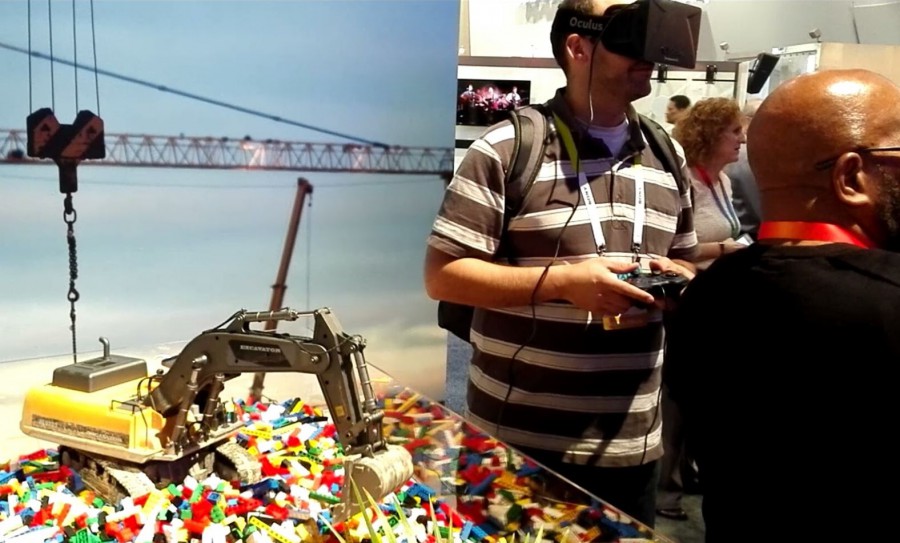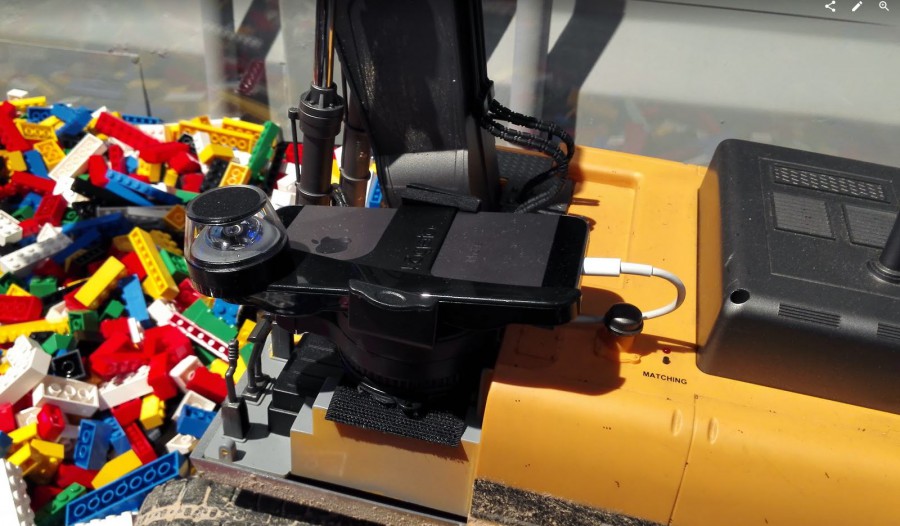

Virtual Reality is about to go mainstream and there’s one company responsible, Oculus. Their technology was so impressive, they got bought by Facebook. With their focus on the high-end of the market, they partnered with Samsung to create a consumer friendly Gear VR, that’s available for just US$99, you just have to bring the phone. Its eleven to midnight on 2015, so 2016 will be the year where VR becomes a reality for most people. It may not mean you buy it, but you’ll almost certainly get to try it and chances are, if you try it, you’ll buy it.
There hasn’t been a technology product that I’ve been this excited about for years, maybe even a decade. Almost all other platforms have matured and become incremental, so its incredibly rare that a new category (technically old), could have such a revolutionary impact on society. What’s on the table here is the hardware and software platform (GearVR powered by Oculus) that will let us be in the Matrix.
There’s a scene in the first Matrix movie where Trinity goes to fly a helicopter and doesn’t know how. Show downloads the training program to her brain and seconds later, she has that skill and navigates that chopper like a veteran of the skies. What this product offers is an opportunity to transport yourself to different places around the world in seconds. While gaming and entertainment are obvious uses for the technology, its perhaps the educational benefits that are the most interesting.
There’s an amazing app called The Body VR in which you’re transplanted into a cell, moving through the bloodstream as you learn about the human heart. As you travel along a pre-set path, you almost unknowingly are being taught biology. I think about students in classrooms who turn off to traditional methods of delivery and imagine the possibilities with VR to engage them in different and more meaningful and perhaps more importantly, more memorable ways. What better tool could a teacher have at their disposal, than something that offers total immersion into an environment, away from all distractions.
Setup
My entry into the Gear VR wasn’t a smooth one. Excited about the opportunity of VR going mainstream, I imported a Gear VR from Amazon in the US, given its not yet available in Australia. After the initial excitement of unboxing had passed, I connected it to my phone and wasn’t met with the voice prompt as listed in the manual. Basically at this point, I had bought an expensive Google Cardboard that worked great for Cardboard apps, but without Gear VR software it was disappointing.
After realising I had a S6 Edge+ from Europe, I found there was an update available, just not over-the-air. Using Samsung Kies3, their own firmware management solution for PCs, I put the phone into restore mode and pushed an updated firmware. The Gear VR processes immediately showed up on the App Manager and I knew I was right to go. Sure I had to format my phone to get it, but to get the Gear VR working, it was definitely worth the hassle of reinstalling my apps.
After connecting the phone the app started installing. Then with the Gear VR store loaded, it was time to go nuts on downloading apps.
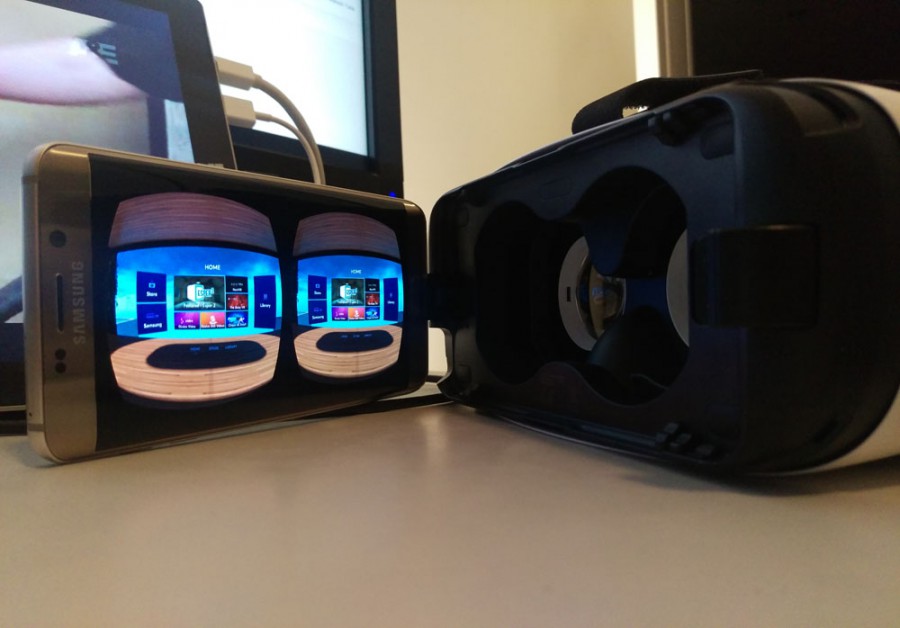

Oculus app / Gear VR Store
There’s a good cross section of free and paid apps, a surprising amount of paid actually, but generally the prices are only a few dollars, I think the most expensive I’ve seen is $8-$9.
Apps like Netflix, Flickr, Samsung Browser, Oculus 360 Photos, Oculus 360 Videos are all free, as are many others, so while you have to add a credit card (no PayPal unfortunately) during setup, you can do a lot for free. Of course that free comes after the cost of an expensive phone a couple hundred on the Gear VR.
Apps fall into 4 main categories, Apps, Videos, Concepts and Experiences. These are apt titles, especially the last 2, while you can have a mobile experience while you’re playing Angry Birds, the immersion offered by the Gear VR do feel much more like a full audio visual experience. The concepts are really developers trying stuff out, and as VR is still in its infancy, that’s fantastic.
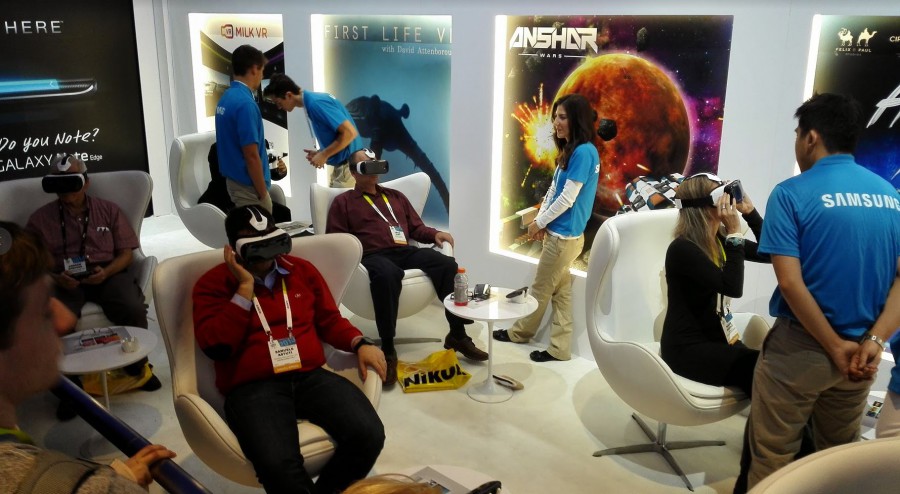

Control schemes
You will notice that the way you interact inside applications is often different. Developers are encouraged to stick to interface norms, but you can see a lot of experimentation there. Tap to select is often used, as is tap and hold, sometimes to confirm a selection and other times to access options, akin to a right-click.
The Gear VR also has that up, down, left, right pad on the right, which you discover can be used to scroll lists, or pages of content, this isn’t immediately obvious, but is natural. Tap and hold, while panning with your head requires a bit more co-ordination, but is also effective.
In reality, some apps do a better job of this than others. Often you’ll get a quick tutorial at first run, while other apps let you discover. I’m happy for developers to experiment now, but in the coming months and years, its likely we’ll settle into UI/UX norms, like pull to refresh on phones.
There are actual, physical controllers available for the Gear VR, but I didn’t have one for review. Surrounded in a half dozen Xbox One and Xbox 360 controllers, I’d love to see someone join those two dots together as I’m guessing I’m not alone there.
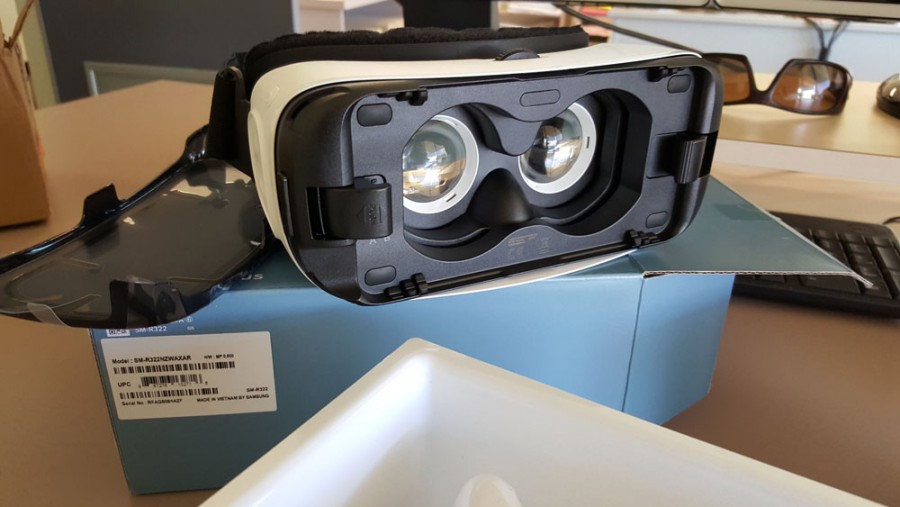

Quality
Despite having amazing 4K quality screens in our mobile phones, VR is definitely a reason manufacturers can’t stop there. Those millions of pixels looks fantastic at arms length, but when you look at them from 2cm away, it looks like you’re looking through a screen door. This is far more substantial than I had imagined, but when you think through what’s being done here, it makes sense.
This does low-quality video or game graphics are multiplied and really bring the experience down. As does slow frame rates. In traditional video, we’re in the middle of a transition from 30fps to 60fps and to do 60fps in 360 degrees is hard.
The one final thing I’ll say about quality is that the Gear VR certainly doesn’t threaten the Oculus Rift, which will be the best VR experience available to consumers. Of course the price point gap between the Gear VR and the Rift, make them hard to compare. Not everyone with a phone can use the Gear VR (Samsung only and 4 models currently), while the Rift requires a dedicated gaming rig, not something many have.
I am very concerned that the Gear VR will be my gateway drug into VR and when that drug kicks in, I’ll need to pony up the cash to get the real solution.
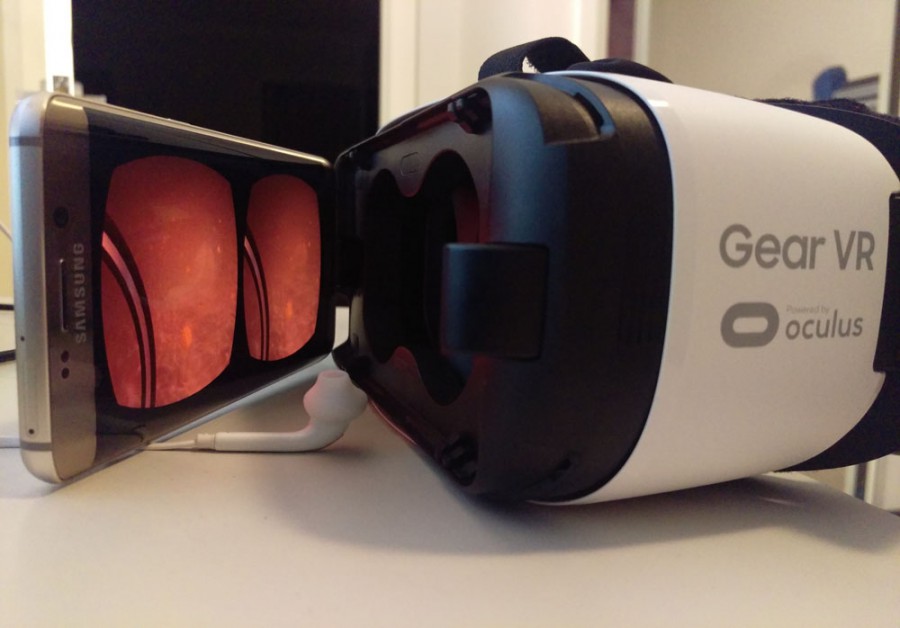

Experiences
Netflix
Sitting in a lux lounge room invites you to put your feet up on the coffee.. but you can’t. What you can do is enjoy the massive screen in front of you, taking up 95% of your vision. Its hard to estimate how big this screen feels, maybe a 120” when you’re 2 meters away, it takes almost all of your peripheral vision.
Its easy to ask, why not just fill the screen with the video, the answer is immersion. There’s something that happens in the brain when you move your head and what you see in front of your eyes reflects that movement accurately. I’m not talking quality here, just the motion accuracy and if anything, this is Gear VR’s biggest success.
Logging into the app I thought would be a pain, but as we create new UI norms for VR, virtual keyboards actually work phenomenally well. Of course there is the option of a Bluetooth keyboard for entering text, but honestly something like a username and password you enter once, is a breeze. Just look at each letter and tap the touchpad over your right temple. Your head and neck are surprisingly good at aiming a cursor, which is really one step away from eye tracking (maybe sometime in the future).
Flickr
Only just released this week, the free Flickr app is a filter on 360 immersive images taken around the world. With a couple of taps, you can transport yourself around the globe. In many of the video apps, its easy to spot where the camera source was, but in Flickr images, you’re able to look down and you’ll find yourself able see the ground far below you. This gives a little sense of vertigo, so if you’re nervous about heights, you have been warned.
Speech Center – VR Public Speaking Simulator
Designed as the first part of a multi-part series to overcome your fear of public speaking, this app is another great example of how VR can and will be used as a learning tool.
One of my favourite, most noticeable memories of this app is the use of dynamic lighting, providing a sense of realism, so as you moved your head, the lens flares from the overhead lights would react accordingly. There is a section where the speaker talks about you’re position in relation to the audience, and you’re physically moved to be a giant, high above audience. I think there’s real lessons to be learned about moving the participant when they’re supposed to be in control of the camera position, this was incredibly disjointing. Overall a great app and subsequent tutorials will likely come at a cost. Expect the freemium model to be strong in the VR marketplace.
Oculus Video
When most video starts playing, you get a low-quality stream, then as more bandwidth is available, the quality is increased. This usually isn’t a problem, but thanks to your proximity to the screen, there’s no room for low-resolution video, even for a few seconds. I didn’t get any serious feelings of sickness, but the one time I did feel off, was during a really low res start to the Mythbusters swimming with sharks.
Given users get to play director in 360 degree video, it requires far more pixels to be rendered than regular video. If the Gear VR was to just render what you’re immediately facing and wait till you turned your head to render the rest, you’d always catch it and the experience would be broken. Instead more pixels are rendered than needed at any one time, which means the bandwidth requirements on VR streaming are massive. I’m on a strong ADSL2+ connection, syncing around 16-17Mbps, but if the connection gets shared, like another Netflix stream starts, then things get rough, fast.
One of the coolest experience I’ve had is starting to watch a Twitch gaming stream and being in a virtual movie theatre. Looking around all the seats were empty, but the live chat to the right of the screen showed the channel was very much alive. Immediately the mind jumps to the opportunity to see other Gear VR users in the same theatre next to you. Even if you couldn’t interact, it’d feel much more like a social experience, like seeing a feature film together, despite not talking to one another.
The potential for social VR video experiences is high, although yet unproven. Its still very early days and you can bet a new generation of Second Life will be born, maybe Third Life. Watching videos together in a virtual cinema is something Xbox tried and failed at, but somehow this would feel different, rather than see your avatar seated in the movie seats, you would be and not 3rd person, first person, making all the difference.
NextVR
This app is your go to place for live events. Currently it features replays of the CNN Democratic debate, Oculus Connect2 conference, and a Manu vs Barcelona football match. In the case of the Oculus conference, you get front row seats to see Brendan Iribe, CEO, Oculus talk to developers about writing for their platform. This is just one example of the positional benefit you could obtain by tuning into real life events in virtual reality.
Thanks to physics, we can’t all sit in the perfect position in a movie theatre, or auditorium, but stick a 360 degree camera there and you could have millions of people, all with the best seat in the house. For the soccer match, you’re not half way up the stadium seating, you’re on the sideline and this could be true, will be true of every major sporting event on the planet soon. WWE have already partnered with Samsung to deliver ring-side seats to wrestling matches and you can bet, charging a premium for it.
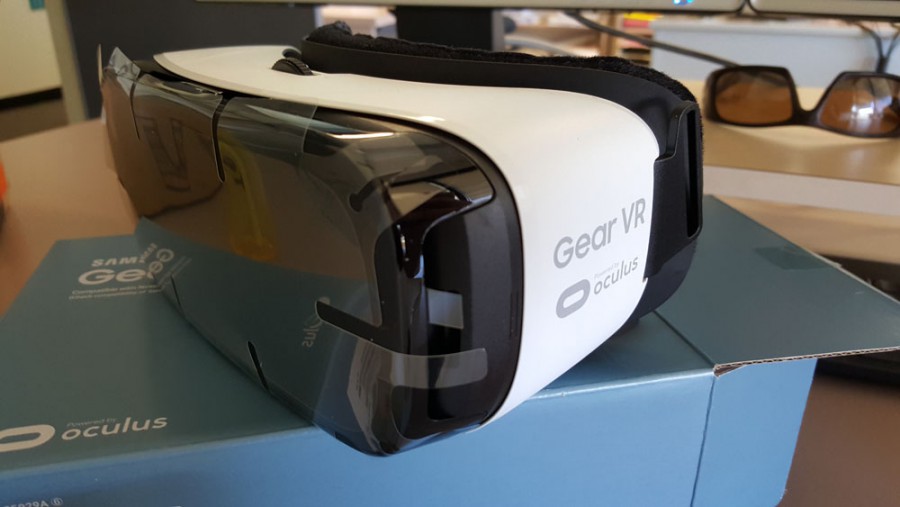

Comfort
The new consumer friendly Gear VR weighs just 318 grams, making it light enough to be practical for hours of use at a time. While it does protrude 92mm from your face and have the weight of your phone at the furthest edge, it is comfortable. The top strap is completely optional and you can certainly get away without it. If you’re passing it around to your friends or colleagues (you will be) then I think the top strap is a good option as it lets the user pop it on much like a helmet and the position is kind of perfect every time.
Every person has different eye sight and to cater for that, Samsung offers a focus wheel at the top of the device, after some quick experimentation, usually while looking at some text, you’ll have it just right and forget about adjustments and move on to enjoying the experience.
Most environments are designed for use when you’re sitting up and able to rotate in 360 degrees, kind of showing off if you like, but there were times where I wished I could simply lay down in bed with the Gear VR and watch a movie, but the interface wasn’t movable in that orientation. There are some cardboard apps that allow for this, so it is possible. Basically you select a UI option to reorient, then you have a few second to change position (i.e. lay down) and then the interface will take where you’re looking as the center position. All future head movements are treated as relative to that center.
Negatives
One of the first negatives is the difficulty there is in showing other people the experience. Usually products sell themselves when you can sit someone in front of a device, or even in a vehicle, but when VR has to be experienced to convince a potential buyer, there is a problem there. Sure enthusiasts like myself will take the gamble, but not everyone’s like that. I do worry that even if you had 3-4 minutes in-store, that you’d struggle to understand everything that’s on offer here.
In practical terms, Samsung would benefit by providing a method to wireless stream the video from the phone to the web. Again this is a difficult challenge, given the person wearing it needs to see the visuals in side-by-side mode for each eye, while the average consumer with VR devices needs that in regular video outputs.
Something you also need to consider is battery life. With the screen constantly on during a VR session, its one of the most brutal things you can do on your phone. Thankfully Samsung have included a micro-USB port in the bottom of the headset that does pass-through power. This is where portable battery packs come in handy, because the cable is only connecting you to your pocket, maintaining your freedom to rotate in your office chair. If you have to connect to a PC, it’ll still work, but your movement will be impacted. If you’re just watching Netflix, this won’t matter.
VR Buffering is hell
As a consequence of connecting your charger, your Android phone may do activities it otherwise wouldn’t. One example of this is backups, which are typically only permitted on WiFi. If you throw your phone on the charger overnight, it doesn’t matter that your bandwidth goes to hell, but if you’re trying to watch stream quality VR, it absolutely does. If you think buffering on the web or your phone is annoying, buffering in VR is an absolute clown-nightmare. Think about it, your entire vision taken up with nothing but a loading circle, it just plain sucks and key reason why all countries need sustained, continued investment in improved internet speeds.
Turning off backup will often fix this problem, however then leaves you susceptible to data loss. To solve this, Android really to detect VR content being consumed and pause backups.
Large downloads
Some apps look small at first, maybe 20-30MB, but once you have you’re Gear VR on and are ready to enjoy them, you get hit with another in-app download, the biggest I’ve seen is 750MB. Unless you’re on 1Gbps FTTP NBN, you’ll likely need to take off your Gear VR, go do something else for a while and come back. Not exactly the greatest experience and I think there should be an option to download content on installation of the app to avoid this problem.
Breaks
The manual for the Gear VR suggests you should take at least a 10-15 minute break every 30 minutes, even if you don’t think you need it. It goes on to suggest that you should not drive a car or operate heavy machinery if you’re experiencing any adverse symptoms after using the Gear VR. Personally I didn’t have these issues, but may be worth keeping in mind. Possibly a better reason to take a break is to make sure nobody has robbed your house while you’ve been on the other side of the planet. There is a sense of vulnerability you get when wearing the headset while wearing headphones. There’s very few times in my life where I’ve essentially been blind and deaf to the outside world, that takes some getting used to.
Warning to your loved ones, come up with a way to bring you out of VR, as a typical tap on the shoulder or arm at the wrong time could be a little traumatic.
Cleaning
Human skin emits oil and when you touch things like glass, it leaves residue that shows itself in the form of a smudge. If you’re trying to look through that glass smudges are the enemies. This means you’ll want to have a microfiber cloth close by. Cleaning is such an issue, there were times I wished I had a dedicated VR phone that I could leave in the Gear VR to avoid this problem. People may also touch the glass lenses inside the headset which also require cleaning.
Price and Availability
The Gear VR Innovators edition was released some time ago, but what we’re talking about here is the Gear VR consumer edition. Samsung have iterated on the original edition, with changes to the touchpad on the right, the back button, slight colour changes and some additional venting to reduce fogging. The biggest change by far was to weight and price.
The Samsung Gear VR is available now (from 15th December 2015) and costs A$159 in Australia (US$99).
More information available from Samsung.


Overall
If you have a compatible phone, a Note 5, S6, S6 Edge or S6 Edge+ then you’d be crazy not to get this. The Gear VR is undoubtedly the best phone accessory ever made. The experience is new and until augmented reality arrives in a serious way, will be the most important tech product in the next few years. I have no doubt that 5 years from now, we’ll look back to this, the Gear VR consumer edition that commoditised the hardware and started us down a path we could only imagine.
If you don’t have a phone, then you’re probably up for somewhere between $1,000-$1,500 to access VR, still substantially less than the Oculus Rift or Microsoft’s HoloLens, both still in development. When I think about the thousands that got spent in education on smart boards, touchscreens and iPads, I get frustrated. They felt like a fad, while an investment into VR feels like real money spent getting everyone to the future. This will move fast and the issues around resolution and internet connections will get fixed, so the question is if, its really when you should buy.
At CES in January this year, the Ericson booth were showing off a preview of the future with a simulation of a remote worker operating an excavator remotely using a VR headset, a controller and some network wizardry. In a real world implementation, there’d have to be a million fail safes, but the concept was proven. If you thought VR was just for gaming, think again, some of the top companies in the world are watching closely to improve their operations. Like the implementation of drones in the military, taking humans out of the field of risk, could very well result in a zero next to the workplace injury list.
Developers are jumping into VR quickly and that will only explode from here, as the addressable market dramatically grows. With Samsung now offering paid apps in the Store, it spawns a new platform for developers to make money from, you just have to nail the experience. There’s still app descriptions, screenshots and ratings to help users make their decisions. While the VR UI and UX isn’t set in stone, there’s plenty of scope for experimentation. For those businesses and education providers looking to how people will work in the future, you have your answer, VR is the real deal, its fantastic and its on our doorstep now.
Make no mistake, industries, people and societies will be changed because of VR and the Gear VR will play a key part in all of it.
